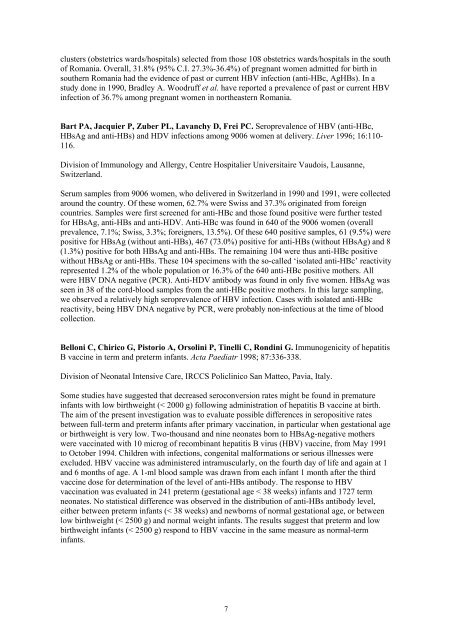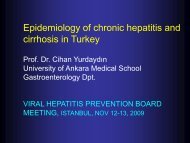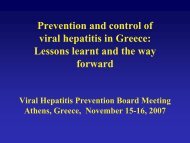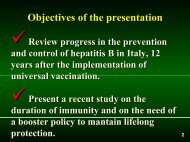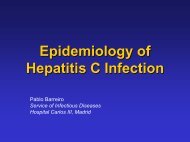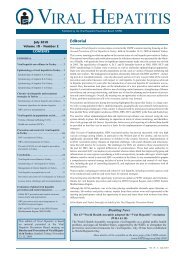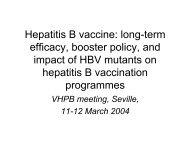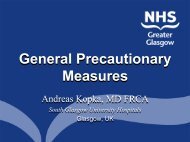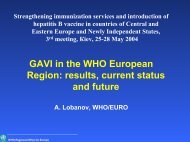HBV-endemic areas, PT <strong>in</strong>fants, irrespective <strong>of</strong> their birthweights, may benefit from an additionaldose <strong>of</strong> <strong>hepatitis</strong> B vacc<strong>in</strong>e <strong>in</strong> a schedule start<strong>in</strong>g at birth. This approach will prevent vertical<strong>transmission</strong> <strong>and</strong> br<strong>in</strong>g their immune response up to par with term <strong>in</strong>fants. Term <strong>in</strong>trauter<strong>in</strong>egrowth-retarded <strong>in</strong>fants should be vacc<strong>in</strong>ated as per the schedule recommended for normal term<strong>in</strong>fants. However, studies <strong>in</strong> other sett<strong>in</strong>gs with different vacc<strong>in</strong>e formulations <strong>and</strong> a longer followupperiod will be required before this strategy can be practised more widely.Asratian AA, Melik-Andreasian GG, Mkhitarian IL, Aleksanian IuT, Shmavonian MV,Kazarian SM, Mkhitarian RG, Kozhevnikova LK. Seroepidemiological characterization <strong>of</strong><strong>virus</strong> <strong>hepatitis</strong> <strong>in</strong> the Republic <strong>of</strong> Armenia. Zh Mikrobiol Epidemiol Immunobiol 2005; 5:93-96.[Article <strong>in</strong> Russian]The survey <strong>of</strong> the population immunological structure with respect to parenteral <strong>hepatitis</strong> showedawide circulation <strong>of</strong> <strong>hepatitis</strong> B (HB) <strong>and</strong> <strong>hepatitis</strong> C (HC) <strong>virus</strong>es among the adult population <strong>of</strong>Armenia. Dur<strong>in</strong>g the 5 year period <strong>of</strong> observation the number <strong>of</strong> persons hav<strong>in</strong>g antibodies to HC<strong>virus</strong> <strong>in</strong>creased 2.7-fold. High occurrence <strong>of</strong> antibodies to HBsAg <strong>of</strong> HB <strong>virus</strong> among the healthypopulation <strong>in</strong> 2002 (12.0%) <strong>in</strong> comparison with 1997 (5.4%) reflected a decreased <strong>in</strong>fection ratewith HB <strong>virus</strong> as well. Antibodies to <strong>hepatitis</strong> A (HA) <strong>virus</strong> were isolated, on the average, <strong>in</strong> 64 %<strong>of</strong> persons. Simultaneously with a decrease <strong>in</strong> the proportion <strong>of</strong> HA cases an <strong>in</strong>creased number <strong>of</strong>HC patients was registered. No circulation <strong>of</strong> <strong>hepatitis</strong> E <strong>virus</strong> was detected. A high percentage <strong>of</strong><strong>hepatitis</strong> cases <strong>of</strong> mixed etiology was established, as well as an <strong>in</strong>creased number <strong>of</strong> comb<strong>in</strong>edparenteral <strong>hepatitis</strong> cases was registered (57.1%).Asratian AA, Isaeva OV, Mikhailov MI. Tendency <strong>and</strong> analysis <strong>of</strong> the epidemic situation <strong>in</strong>parenteral <strong>virus</strong> <strong>hepatitis</strong> B <strong>and</strong> C <strong>in</strong> the Russian Federation <strong>and</strong> a number <strong>of</strong> its regions. ZhMikrobiol Epidemiol Immunobiol 2005; 4:40-45. [Article <strong>in</strong> Russian]As revealed <strong>in</strong> the present survey, dur<strong>in</strong>g the last 3 years, aga<strong>in</strong>st a background <strong>of</strong> decreasednumber <strong>of</strong> registered cases <strong>of</strong> acute <strong>hepatitis</strong> B (HB) <strong>and</strong> acute <strong>hepatitis</strong> C (HC), an <strong>in</strong>crease <strong>in</strong> theproportion <strong>of</strong> patients with the chronic forms <strong>of</strong> these diseases was observed. The <strong>in</strong>cidence rate <strong>of</strong>carriership <strong>of</strong> <strong>hepatitis</strong> B (HBV) <strong>and</strong> <strong>hepatitis</strong> C <strong>virus</strong>es (HCV) is many times greater thanmorbidity rates <strong>in</strong> acute <strong>and</strong> chronic forms <strong>of</strong> the disease. Such differences could be due toimperfect laboratory <strong>and</strong> cl<strong>in</strong>ical diagnosis. The registered statistics on HBV <strong>and</strong> HCV carriership<strong>in</strong>cluded newly detected HBsAg <strong>and</strong> anti-HCV <strong>in</strong> the absence <strong>of</strong> cl<strong>in</strong>ical manifestations, which didnot reflect the true spread <strong>of</strong> HBV <strong>and</strong> HCV <strong>in</strong> a given territory. The group <strong>of</strong> HBV <strong>and</strong> HCVcarriers was found to <strong>in</strong>clude a considerable proportion <strong>of</strong> patients with asymptomatic form <strong>of</strong> HB<strong>and</strong> HC. It was test<strong>in</strong>g for HBsAg, anti-HCV only without determ<strong>in</strong>ation <strong>of</strong> <strong>virus</strong> replicationmarkers (anti-HBc IgM, HBV DNA, anti-HCV IgM, HCV RNA) that seem<strong>in</strong>gly determ<strong>in</strong>ed thecategory <strong>of</strong> carriers greatly exceed<strong>in</strong>g the true <strong>in</strong>cidence. To obta<strong>in</strong> reliable epidemiological<strong>in</strong>formation, the complex detection <strong>of</strong> HB <strong>and</strong> HC <strong>in</strong>fection markers is necessary.Balan A, Beldescu N, Popa R. The prevalence <strong>of</strong> viral <strong>hepatitis</strong> B <strong>in</strong> pregnant women <strong>in</strong> an area<strong>of</strong> southern Romania. Bacteriol Virusol Parazitol Epidemiol 1998; 43:254-260. [Article <strong>in</strong>Romanian]Institutul de Sanatate Publica Bucuresti.In Romania, the acute <strong>hepatitis</strong> B <strong>virus</strong> (HBV) <strong>in</strong>fections are considered to be a public healthproblem. One <strong>of</strong> the most effective routes <strong>of</strong> <strong>transmission</strong> is from <strong>in</strong>fected mothers to newbornsboth <strong>per<strong>in</strong>atal</strong> <strong>and</strong> <strong>in</strong> early childhood. That for, this study objective was to estimate the prevalence<strong>of</strong> <strong>hepatitis</strong> B <strong>in</strong> pregnant women. We used the cluster sampl<strong>in</strong>g method with a sample size <strong>of</strong>1356 pregnant women. F<strong>in</strong>ally our study was based on 1298 blood samples com<strong>in</strong>g from 196
clusters (obstetrics wards/hospitals) selected from those 108 obstetrics wards/hospitals <strong>in</strong> the south<strong>of</strong> Romania. Overall, 31.8% (95% C.I. 27.3%-36.4%) <strong>of</strong> pregnant women admitted for birth <strong>in</strong>southern Romania had the evidence <strong>of</strong> past or current HBV <strong>in</strong>fection (anti-HBc, AgHBs). In astudy done <strong>in</strong> 1990, Bradley A. Woodruff et al. have reported a prevalence <strong>of</strong> past or current HBV<strong>in</strong>fection <strong>of</strong> 36.7% among pregnant women <strong>in</strong> northeastern Romania.Bart PA, Jacquier P, Zuber PL, Lavanchy D, Frei PC. Seroprevalence <strong>of</strong> HBV (anti-HBc,HBsAg <strong>and</strong> anti-HBs) <strong>and</strong> HDV <strong>in</strong>fections among 9006 women at delivery. Liver 1996; 16:110-116.Division <strong>of</strong> Immunology <strong>and</strong> Allergy, Centre Hospitalier Universitaire Vaudois, Lausanne,Switzerl<strong>and</strong>.Serum samples from 9006 women, who delivered <strong>in</strong> Switzerl<strong>and</strong> <strong>in</strong> 1990 <strong>and</strong> 1991, were collectedaround the country. Of these women, 62.7% were Swiss <strong>and</strong> 37.3% orig<strong>in</strong>ated from foreigncountries. Samples were first screened for anti-HBc <strong>and</strong> those found positive were further testedfor HBsAg, anti-HBs <strong>and</strong> anti-HDV. Anti-HBc was found <strong>in</strong> 640 <strong>of</strong> the 9006 women (overallprevalence, 7.1%; Swiss, 3.3%; foreigners, 13.5%). Of these 640 positive samples, 61 (9.5%) werepositive for HBsAg (without anti-HBs), 467 (73.0%) positive for anti-HBs (without HBsAg) <strong>and</strong> 8(1.3%) positive for both HBsAg <strong>and</strong> anti-HBs. The rema<strong>in</strong><strong>in</strong>g 104 were thus anti-HBc positivewithout HBsAg or anti-HBs. These 104 specimens with the so-called ‘isolated anti-HBc’ reactivityrepresented 1.2% <strong>of</strong> the whole population or 16.3% <strong>of</strong> the 640 anti-HBc positive mothers. Allwere HBV DNA negative (PCR). Anti-HDV antibody was found <strong>in</strong> only five women. HBsAg wasseen <strong>in</strong> 38 <strong>of</strong> the cord-blood samples from the anti-HBc positive mothers. In this large sampl<strong>in</strong>g,we observed a relatively high seroprevalence <strong>of</strong> HBV <strong>in</strong>fection. Cases with isolated anti-HBcreactivity, be<strong>in</strong>g HBV DNA negative by PCR, were probably non-<strong>in</strong>fectious at the time <strong>of</strong> bloodcollection.Belloni C, Chirico G, Pistorio A, Orsol<strong>in</strong>i P, T<strong>in</strong>elli C, Rond<strong>in</strong>i G. Immunogenicity <strong>of</strong> <strong>hepatitis</strong>B vacc<strong>in</strong>e <strong>in</strong> term <strong>and</strong> preterm <strong>in</strong>fants. Acta Paediatr 1998; 87:336-338.Division <strong>of</strong> Neonatal Intensive Care, IRCCS Policl<strong>in</strong>ico San Matteo, Pavia, Italy.Some studies have suggested that decreased seroconversion rates might be found <strong>in</strong> premature<strong>in</strong>fants with low birthweight (< 2000 g) follow<strong>in</strong>g adm<strong>in</strong>istration <strong>of</strong> <strong>hepatitis</strong> B vacc<strong>in</strong>e at birth.The aim <strong>of</strong> the present <strong>in</strong>vestigation was to evaluate possible differences <strong>in</strong> seropositive ratesbetween full-term <strong>and</strong> preterm <strong>in</strong>fants after primary vacc<strong>in</strong>ation, <strong>in</strong> particular when gestational ageor birthweight is very low. Two-thous<strong>and</strong> <strong>and</strong> n<strong>in</strong>e neonates born to HBsAg-negative motherswere vacc<strong>in</strong>ated with 10 microg <strong>of</strong> recomb<strong>in</strong>ant <strong>hepatitis</strong> B <strong>virus</strong> (HBV) vacc<strong>in</strong>e, from May 1991to October 1994. Children with <strong>in</strong>fections, congenital malformations or serious illnesses wereexcluded. HBV vacc<strong>in</strong>e was adm<strong>in</strong>istered <strong>in</strong>tramuscularly, on the fourth day <strong>of</strong> life <strong>and</strong> aga<strong>in</strong> at 1<strong>and</strong> 6 months <strong>of</strong> age. A 1-ml blood sample was drawn from each <strong>in</strong>fant 1 month after the thirdvacc<strong>in</strong>e dose for determ<strong>in</strong>ation <strong>of</strong> the level <strong>of</strong> anti-HBs antibody. The response to HBVvacc<strong>in</strong>ation was evaluated <strong>in</strong> 241 preterm (gestational age < 38 weeks) <strong>in</strong>fants <strong>and</strong> 1727 termneonates. No statistical difference was observed <strong>in</strong> the distribution <strong>of</strong> anti-HBs antibody level,either between preterm <strong>in</strong>fants (< 38 weeks) <strong>and</strong> newborns <strong>of</strong> normal gestational age, or betweenlow birthweight (< 2500 g) <strong>and</strong> normal weight <strong>in</strong>fants. The results suggest that preterm <strong>and</strong> lowbirthweight <strong>in</strong>fants (< 2500 g) respond to HBV vacc<strong>in</strong>e <strong>in</strong> the same measure as normal-term<strong>in</strong>fants.7
- Page 1 and 2: Pre-meeting documentPrevention and
- Page 3 and 4: Part I Prevention and control of pe
- Page 5: prevalence was significantly higher
- Page 9 and 10: Boxall E. Screening of pregnant wom
- Page 11 and 12: Chang MH, Hsu HY, Huang LM, Lee PI,
- Page 13 and 14: of infection in infants and childre
- Page 15 and 16: Eriksen EM, Perlman JA, Miller A, M
- Page 17 and 18: liver enzyme abnormalities than wer
- Page 19 and 20: health care, is feasible and achiev
- Page 21 and 22: HBsAg and anti-HBs in 4.5%. In the
- Page 23 and 24: immunoprophylaxis. Reflecting effec
- Page 25 and 26: Levin CE, Nelson CM, Widjaya A, Mon
- Page 27 and 28: Delaying vaccination of premature i
- Page 29 and 30: diagnosis. In the past, the inciden
- Page 31 and 32: shows that the prevalence of HBV in
- Page 33 and 34: Niu MT, Targonski PV, Stoll BJ, Alb
- Page 35 and 36: Ranger-Rogez S, Alain S, Denis F. H
- Page 37 and 38: vaccinees) and low reactogenicity o
- Page 39 and 40: single ELISA test is about Rs40. At
- Page 41 and 42: newborns with surface antigenemia,
- Page 43 and 44: Wang Z, Zhang J, Yang H, Li X, Wen
- Page 45 and 46: of hepatitis B vaccine. This study
- Page 47 and 48: transmission has been estimated at
- Page 49 and 50: at birth and 2 weeks after birth, f
- Page 51 and 52: Chubinishvili OV, Mikhailov MI, Sak
- Page 53 and 54: Jensen L, Heilmann C, Smith E, Want
- Page 55 and 56: Onishchenko GG. Incidence of infect
- Page 57:
Zanetti A, Tanzi E, Semprini AE. He


